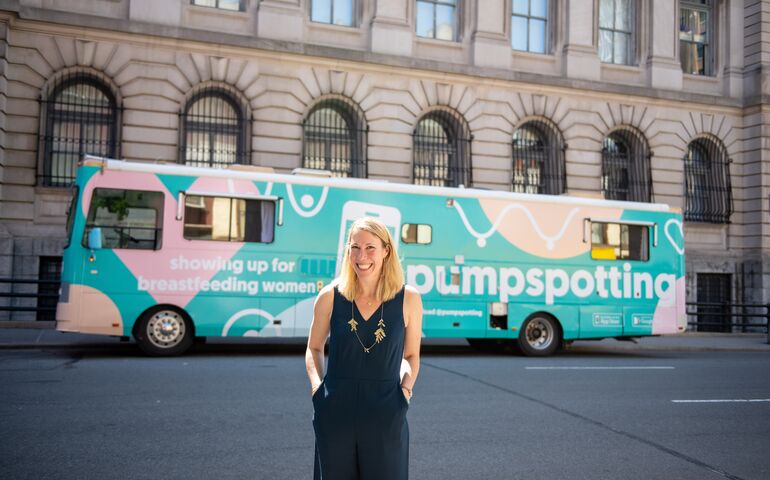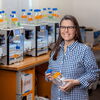Q&A: Kittery entrepreneur builds app for working mothers, launches to employers
 Courtesy / Amy VanHaren
Kittery entrepreneur Amy VanHaren is seen here on a stop in New York City during a five-month tour to learn from working mothers about barriers they face with breastfeeding and pumping.
Courtesy / Amy VanHaren
Kittery entrepreneur Amy VanHaren is seen here on a stop in New York City during a five-month tour to learn from working mothers about barriers they face with breastfeeding and pumping.
In June 2016, Kittery entrepreneur Amy VanHaren launched an app called Pumpspotting, designed to connect parents with each other and with breastfeeding, pumping and postpartum support services. The app has since grown to become an employee benefit platform designed to simplify workplace lactation support as part of a company’s wellness benefits package.
Originally from Michigan, VanHaren moved to Maine almost 20 years ago. A social media specialist, in 2012 she formed VanHaren Creative in Eliot, drawing clients such as Patagonia Provisions and Stonyfield.
VanHaren launched the app in response to her own experience as a working mother who navigated the complicated logistics of maintaining her career – often flying cross-country – while also feeding her baby. Marketing research included two outreach tours, in 2017 and 2019, to speak with parents and with professionals in lactation and related fields.
Initial financing came through a $46,000 Kickstarter campaign followed by over $60,000 raised in brand sponsorships. Her first hire, as chief technology officer, was Lindsey Witmer Collins, a user-experience designer and founder of WLCM App Studio in San Franciso.
This year, VanHaren launched the app’s corporate program, raised $600,000 in seed funding and grew the team to six employees. Last month, she debuted the app’s latest version with new user experience and began raising an additional $560,000 in seed funds, with the goal of growing the sales team, accelerating market growth and reaching more employers.
Mainebiz asked VanHaren about her entrepreneurial journey and what she sees ahead for it. Here’s an edited transcript.
Mainebiz: How did you arrive at this idea?
Amy VanHaren: With my second child, I found myself running a marketing agency in Kittery and having clients in California. I was passionate about being able to feed my child but found myself overwhelmed. It was a massive time commitment: You have to feed every couple of hours and I was flying across country every month. It was a whirlwind of constant pumping and feeding.
I got to the point where I needed connection with other parents navigating this process. The idea was to create a platform where we could talk with one another and share places to pump and insights.
MB: How did you go from idea to app?
AV: I started to sketch the idea for what I thought the platform could be. Then I was introduced to Lindsey. I enlisted her to create the first version of Pumpspotting, which launched in June 2016.
MB: What’s the goal for the app?
AV: We’re making feeding a baby less isolating and more supportive, especially at work. Essentially, Pumpspotting is a breastfeeding and postpartum platform and employee benefits solution. The goal is to reduce barriers around breastfeeding and pumping and to connect parents to one another and to key support services so they have everything they need to succeed in one, virtual, place.
MB: How did the outreach tour come about?
AV: About a year after we launched the first version, Lindsey and I applied to Apple’s reality show ‘Planet of the Apps.’ It was kind of ‘The Voice’ meets ‘Shark Tank’ for app developers. We had a great experience. But as a business, we were too early to need money and know where we were going.
During the taping, Gary Vaynerchuk – one of the celebrity mentors – asked us, ‘How well do you understand these women you want to serve?’ That question struck us. We decided we should get on the road to meet parents. Lindsey had a friend who lived in a 40-foot RV that was redone as a home. We bought the RV and turned it into the “Breast Express” with a nursing and pumping suite. I traveled for five months to over 60 cities, and met about 5,000 parents.
MB: How did you connect with parents?
AV: As part of our Kickstarter campaign, we asked mothers where to go and who to contact. They’d send in requests – ‘Come to our house.’ ‘Come to our hospital. Come to our company.’ We reached out to maternal wellness centers, birthing centers, lactation consultants, midwives.
MB: What did you talk with them about?
AV: How they were doing, what did they need. We always had a local lactation consultant onboard to answer questions. We were bringing this conversation forward in a way, I think and hope, that helps everyone see it as normal and uplifting.
MB: Was it all working mothers?
AV: It was all types of mothers. Many of them were working mothers, but there were also stay-at-home mothers and partners and dads. It was about family, not just mothers. And there were a lot of lactation consultants, doulas and others from the broader community.
MB: How did the tour help you build the business?
AV: It became clear that support specifically for working mothers trying to navigate breastfeeding and pumping was lacking. Employers were starting to think about policies and places to pump but, on the mother side, there was still not enough structure and support for them to be able to both work and feed, because it’s such an emotional journey and a massive time commitment.
MB: How big a time commitment?
AV: If you nurse or pump for a year, it’s 1,800 hours.
MB: Could you describe the logistics, especially if you’re on the road a lot?
AV: There were days I would take a red-eye to San Francisco, be there for 24 or 48 hours, then take the red-eye home to be away as little as possible.
I planned my schedule exactly. Before I left, I pumped at the airport. I pumped on the airplane, pumped in Ubers and would get up in the middle of the night to pump. I scheduled meetings around that. I googled places to get dry ice, drove to those locations, had Amazon ship me coolers, then made time to go to FedEx and overnight it back to my family, frozen in the dry ice. Pumping involves a lot of logistics for everyone, traveling or not.
Some pumps need to be plugged in, so there needs be an outlet. It can take 10 to 45 minutes for a pump session. You have to wash the pump parts afterward and store the milk, so you need refrigeration. You have to navigate schedules and spaces to pump and conversations with managers.
MB: What happened after the first tour?
AV: All those conversations helped us move the business forward. I participated in two MassChallenge accelerator programs. Through MassChallenge HealthTech, we worked with Brigham and Women’s Hospital to help us think about shaping the product and build the business.
We launched the corporate program in February. In April we closed the first part of our seed round for $600,000. MooDoos [Investments, headquartered in San Diego] was our lead investor. Other investors were Maine Venture Fund, Maine Angels, Launchpad Venture Group in Boston and various individuals. That helped us accelerate growth and build the next evolution of the platform, which launched in October.
We added team members, including a community marketing manager and director of business development. We started to add more corporate clients to get Pumpspotting into more workplaces. That’s been our focus over these past six months. We’ve got 27,000 parents and five companies on our platform now.
MB: How does the corporate platform help employers?
AV: We’re removing stress around breastfeeding support for employers. In one platform, we’re able to communicate with parents around breastfeeding policy, give them access to other mothers and parents and lactation consultants, centralize access to places to nurse and pump — both in the workplace and around the world — and enable working parents to continue to work and also feed the family.
All of those things have proven to be better for businesses, to contribute to healthy moms and babies, to lower health care costs, and to produce happier, more capable employees for the workplace. Having employers support working parents is vital right now; with the pandemic we’re seeing mass amounts of women, primarily mothers, leaving the workforce.
MB: How do you get paid?
AV: We sell Pumpspotting to companies as an employee benefit solution. The corporate side has access to Pumpspotting features that can be customized for each company, as part of their employee wellness package. Parents don’t pay now, but we’ll be launching subscriptions at the end of this year. They can purchase the subscription monthly or annually.
MB: What’s on the horizon?
AV: We’re fundraising an additional $560,000 now, to bring on one more sales hire and a sales support team member, and to allow us to accelerate the growth of our product in the market. We have a pipeline of employers. Our long-term vision is to expand our technology, supporting parents as their children age and as parents continue to grow as working parents.










0 Comments